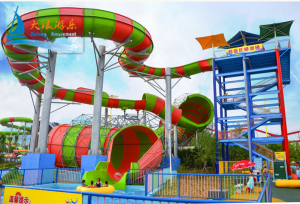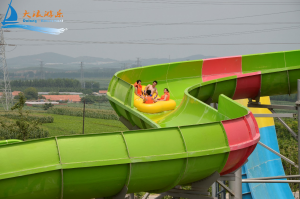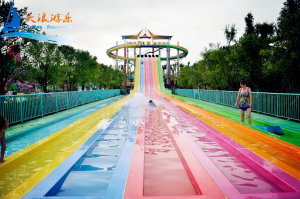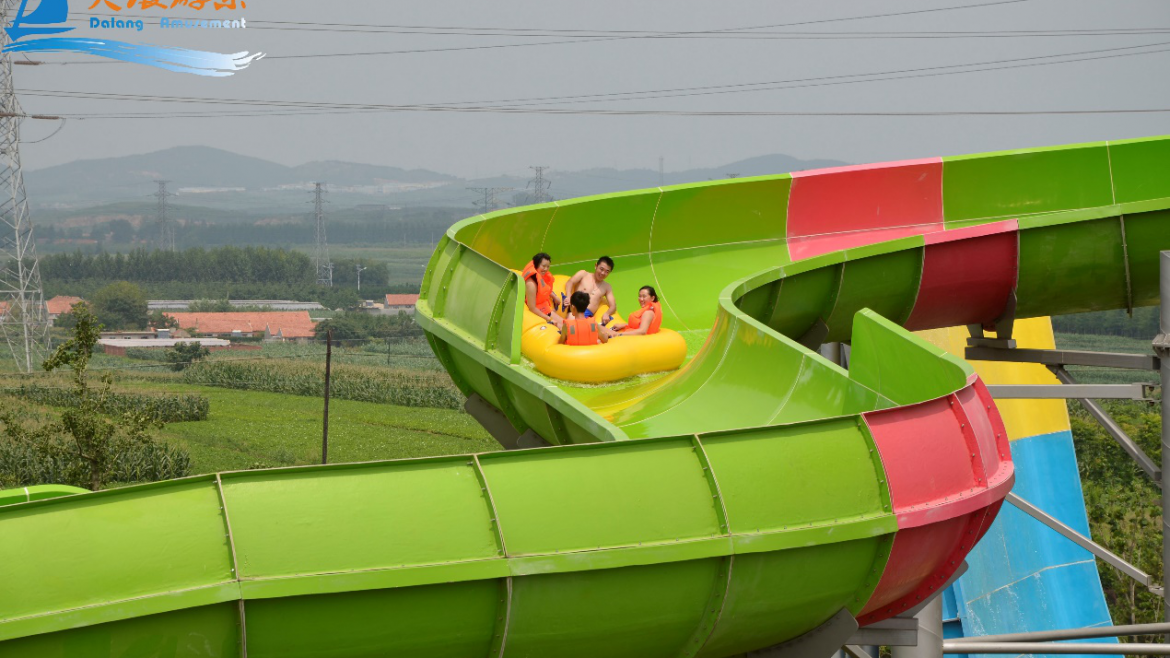In the past 30 years, the water house has exploded, especially the water slides. They have transformed from simple poolside slopes to intricate attractions that dominate entire parks.
Water parks boast slides with dozens of loops, incredible speeds, and exhilarating drops. A water slide is like a wet roller coaster without seat and safety harness, and it uses the same principles of a roller coaster. In this article, we’ll peek behind the scenes to find out what’s involved in operating a water slide, from pumping the water to cleaning it after the ride. We’ll also see how the pieces of a water slide fit together and find out what keeps you from flying off into the air as you whip around corners. Get a quote.

Working principles of water slide
Water slides work on precisely the same principle as a coaster. When the coaster is released at the top of the hill, gravity pulls it off the track. As for water slides, instead of a lift hill, you have a stairway. Climbing the stairs will accumulate a certain amount of potential energy. When you head down the stairs, the potential energy will be converted into kinetic energy. A taller slide has more potential power to work with than a shorter slide.
On a water slide, your body combined with a mat or raft, taking the place of the roller-coaster car. The water slide has a continuous flow of water from top to bottom. The water lubricates the slide to reduce the friction between the slide and your body.
Apart from total height, the main difference of various water slides is the way they put the potential energy to work. The shape of the slide determines this.
How a slide’s shape affects, how fast you fly, and how far you move
The slider exerts an anti-gravity force. The balance of these two forces depends on the angle of the slide. When you slide on a nearly horizontal slope, gravity pulls you directly into the slide, which pushes you up. The upward force of the slide is almost the opposite of the downward force of gravity, which slows down your downward acceleration. When the slope drops sharply, gravity will still pull you down directly, but the inclined slide will no longer push you up directly; instead, it will drive you at an angle between upward and forward. Because the slide is not acting directly on gravity, you accelerate down.
Speed slides and sleigh slides focus only on these up and down forces. On a speed slide, you go straight down the steep hillside, enter an exit sink, a long channel, and slowly slow you down. On the sled, you’ve skied a series of bumps. In both of these slide designs, you move forward in a straight line.
The winding slide adds some new combinations: curves. The slide winds its way to the bottom, whipping you in different directions. In this kind of riding, the slide structure is not only against gravity but also against your own inertia. When you accelerate toward a curve, your body naturally wants to move on. If the slide is flat, you will be thrown into the air on the first sharp turn.
The slide must curve up at these turns to keep you on the ride. When you hit these curves, you can feel a strong force acting on your body. It is the slide accelerating you, changing your forward velocity so that you move in a different direction.
For everything to work correctly in a water slide, you need a sturdy, smooth surface to glide on.Contact us for more information.

The structural elements of water slide
Most of the water slide parks have similar structures, but they are larger. It is not feasible to make a huge curved slide with a piece of glass fiber. The water slide of the water park is made of dozens of fiberglass and fixed together with heavy bolts. Usually, the parts are assembled as part of a toy game.
These segments rest on a framework of steel girder. The trusses may be positioned directly below the slide, or they may sit adjacent to the slide, supporting it with sturdy cantilevers.
Water parks usually buy new slides from outside manufacturers. The manufacturer designed the slides and made all the individual parts. The water park hired a local contractor to assemble the parts according to the manufacturer’s instructions. It’s like building a toy track or model train, but it’s huge. The actual sliding structure accounts for only half of the total.
How does water allow you to slip from the top to the bottom?
To zip down the slide, you need a constant stream of water to reduce friction between you and the fiberglass surface. Most water slides are made with pumps installed in a building near the bottom of the slide. In the standard design, the pump motor rotates the drive shaft attached to the propeller. The rotating propeller propels the water forward. Similarly, the airplane propeller moves the air particles. The pump draws water from the sump, which is usually located at the bottom of the slide and pushes it up to the top of the slide through a narrow pipe. In this way, the water running down the slide is recycled continuously. In some water parks, the water is cycled through several connected pools before it is pumped back up to the top of a slide.
How to keep everything sanitary
The water in the collection pool is also pumped through filters and filtration systems to keep everything clean. A typical filter is a large container filled with sand, which is located at the top of the gravel layer. Water is pumped from the top of the container to the bottom through the gravel layer. The sharp edge of the fine sand catches up the dirt in the passing water.
In the evening, park managers backflow water through the filters. As the water moves up through the sand, it removes some dirt and cleans the filter. The backwash water is pumped to the sewer. In a typical collection tank, all the water passes through the filter several times a day. Any swimming pool is continuously losing water — through filtering, evaporation, and people carrying water away in their swimsuits. The park has to pump in more water to keep the pools filled.

Water slides continue to advance at a breakneck pace. One of the most exciting advancements on the horizon is the so-called “water coaster.” In the past, water slides have been gravity-driven rides; the water doesn’t do much more than help you along on your descent. But some newer designs use water to push you uphill. In these rides, the pump system drives high-pressure water to several points along the slide. When the slide dips, the water jets propel you up the next hill. With this element, designers can make the best water slides that carry you in a complete circle, like a roller coaster. It’s amazing what you can do with only water, plastic, fiberglass, and gravity.
Related Products






